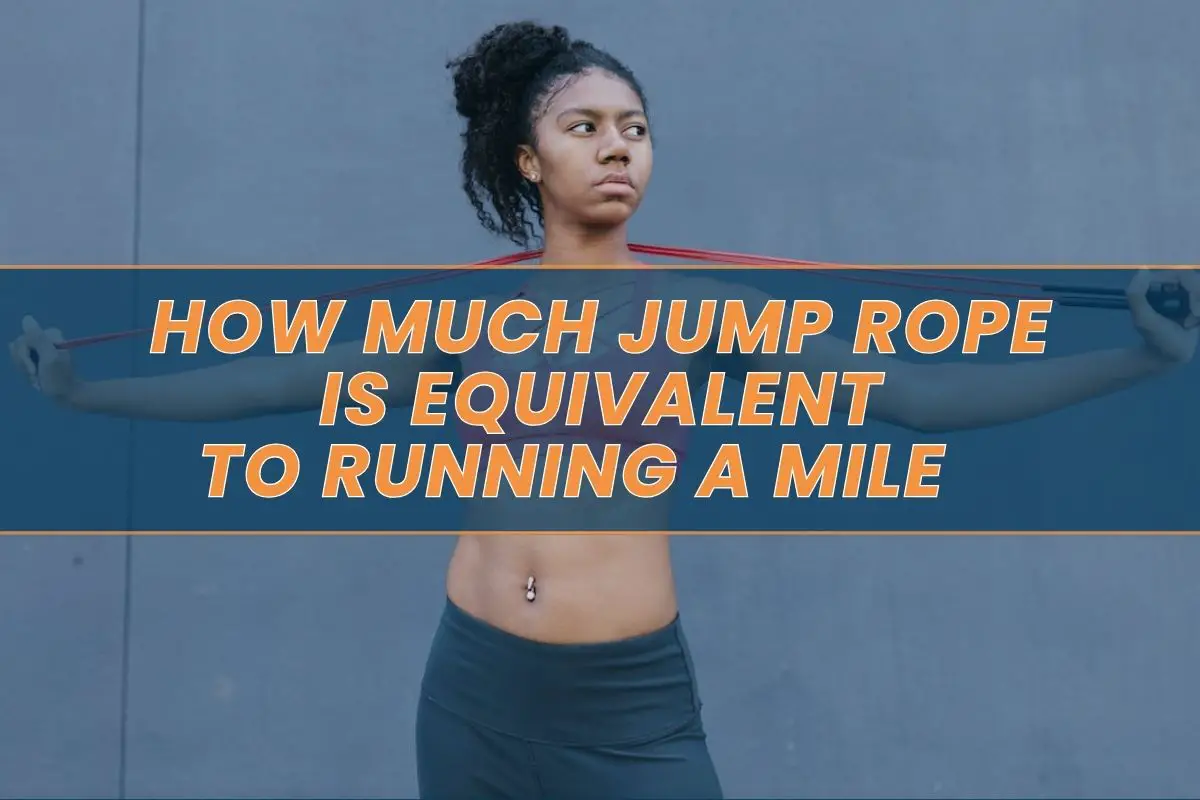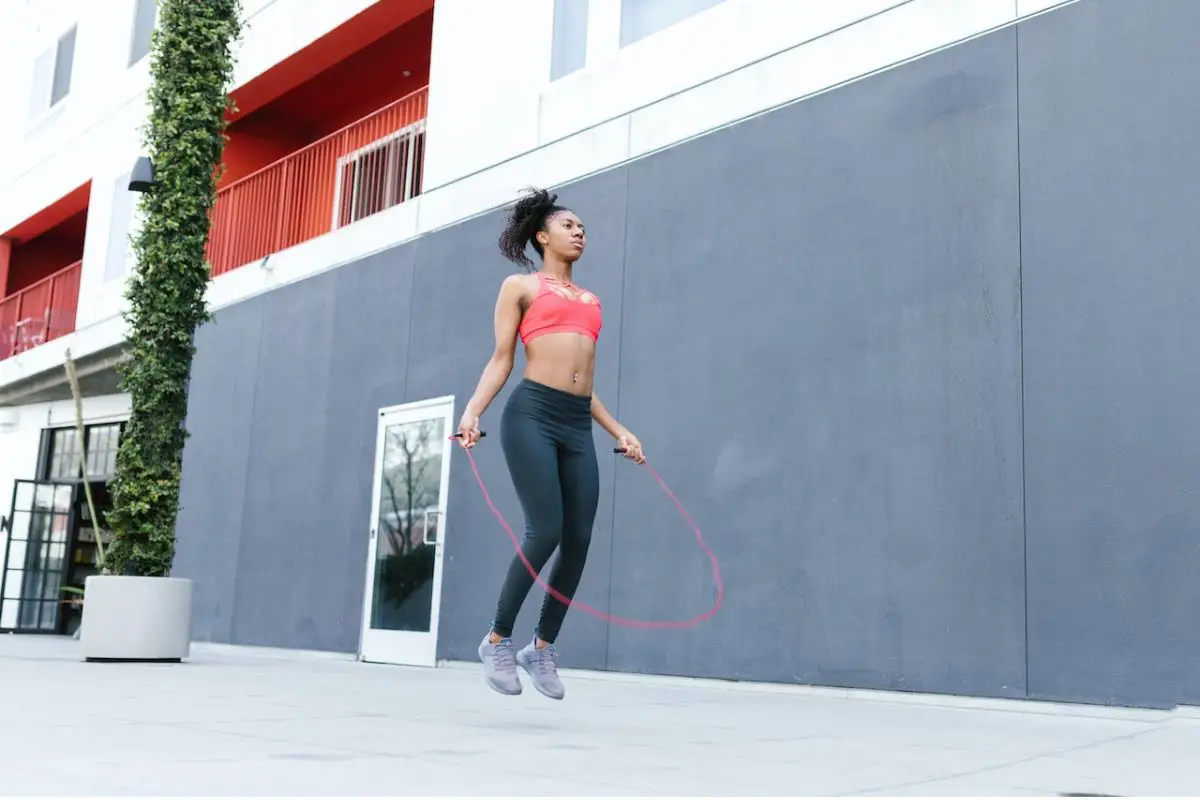How Much Jump Rope Is Equivalent to Running a Mile?
Are you wondering how much jump rope is equivalent to running a mile? Many of us want to get in shape, but we often don’t have enough time to go for a run. Jumping rope can be an excellent way of getting fit and burning calories in less time than it takes to go for a jog.
In this blog post, we’ll discuss what the difference is between jumping rope and running, the pros and cons of each exercise, and how many minutes of jumping rope are equivalent to running 1 mile. So grab your jump rope and let’s dive in!
How many jump ropes equal 1 mile?
Approximately 10 minutes of moderate intensity jump rope can burn the same number of calories as an easy 12-minute mile run. Rope jumping offers similar benefits to running, while also having a lower risk of injury. The equipment needed for jump roping is minimal, making it an ideal exercise option when you’re in a time crunch.

How Many Minutes of Jump Rope Equals a Mile of Running?
Jump rope and running are two great forms of exercise for people looking to get into shape. Jumping rope is an excellent alternative for those who don’t have time to run regularly. But how do jumping rope and running a mile compare?
The answer to this question primarily depends on the intensity at which you jump rope or run. For instance, 1 minute of light-intensity rope jumping will not provide the same calorie burn as 1 minute of high-intensity treadmill running.
How Many Minutes of Jump Rope Equals a Mile?
Having said that, how long to jump rope to equal a mile? Jumping rope provides an equivalent workout as running when done with proper technique. Generally speaking, 8 minutes and 20 seconds of jump roping is equal to one mile of moderate running.
How many jump ropes equal 400 meters of sprinting? If you run 400 meters in 1:30, then you need to jump rope for 1:30 minutes to have the same amount of calories burned. Similarly, 10 minutes of moderate rope jumping approximately equals the same intensity as 12 minutes of jogging and 17 minutes of jump rope equivalent to running 2 miles.
Running vs. Rope Jumping: Is Jumping Rope Equivalent to Running?
Running and rope jumping are both cardio exercises that burn calories, have a relatively low impact on the body, and can help with weight loss and improve aerobic fitness. Running is a strenuous exercise involving covering long distances at a steady pace. Rope jumping is an intense workout developed from running that involves short bursts of energy combined with dynamic footwork. You can measure how much jump rope is equivalent to running 1 mile in terms of minutes. For example, 8 minutes of intense jumping rope equals approximately 1 mile of running.
Jumping Rope vs. Running: Detailed Comparison
Let’s compare rope jumping and running in more detail:
Running vs. Rope Jumping: Calories Burned
Although people have different opinions on which is better for burning calories, the reality is that both offer a great workout with many benefits.
Running generally burns about 12-14 calories per minute, while rope jumping burns approximately 14-16 calories per minute. Technically speaking, you would actually burn slightly more calories by opting for rope jumping instead of running, if you did them for the same amount of time.
It generally takes 8 minutes and 20 seconds of rope jumping to burn the same calories as running a mile (about 100 calories). If you jump rope for 30 minutes you will likely burn 400-500 calories, making this activity an excellent choice for those looking to shed weight quickly and efficiently. Moderate running burns about 300 calories in 30 minutes.
Running vs. Rope Jumping: Muscles Worked
Both running and jumping rope are excellent forms of low-impact cardio exercise that involve the use of lower extremity muscles for propulsion, while relying on core muscles for stability.
While both activities work the entire body, they each focus on different muscle groups to achieve their movement.
Running primarily targets the lower extremity muscles needed for propulsion (the calf muscles, quadriceps, hamstrings, and glutes), while also engaging core muscles that help control balance.
Rope jumping also involves leg muscles and core, but additionally targets arms, shoulders, and obliques.
| Muscle Groups | Running | Jumping Rope |
|---|---|---|
| Lower Extremity Muscles | Calf muscles, quadriceps, hamstrings, glutes | Calf muscles, quadriceps, hamstrings, glutes |
| Core Muscles | Abdominals, lower back | Abdominals, lower back |
| Upper Body Muscles | Not a primary focus | Arms, shoulders |
| Obliques | Not a primary focus | Engaged due to rotational motion |
Running vs. Rope Jumping: Perceived Exertion
When comparing running and rope jumping, it is important to consider how the intensity of the exercise is perceived. Generally speaking, running a mile tends to feel more intense than rope jumping.
Running provides an aerobic challenge, as you increase your heart rate. This increased effort results in higher levels of breathing and fatigue.
Rope jumping also puts strain on muscles and requires cardiovascular endurance. However, experienced jumpers may find that they maintain a lower heart rate, leading to decreased perceived difficulty overall when compared to running for extended periods of time.
| Perceived Exertion | Running | Jumping Rope |
|---|---|---|
| Intensity | Generally perceived as more intense due to continuous motion over distance. | May be perceived as less intense for experienced jumpers due to rhythmic intervals and breaks. |
| Heart Rate | Increases heart rate significantly. | Can raise heart rate, but experienced jumpers may maintain a lower heart rate during jumping sessions. |
| Breathing | Intensity often leads to heavy and rapid breathing. | Requires controlled breathing but may feel less strenuous in terms of breathlessness for some. |
| Fatigue | Can lead to quicker fatigue, especially at high speeds and long distances. | May result in less immediate fatigue for those with good jump rope technique and endurance. |
What Are the Benefits of Rope Jumping?
Rope jumping is a great way to stay active and fit. It’s low-impact, highly aerobic, and can be done almost anywhere with minimal equipment. The health benefits of rope jumping are widely recognized by medical professionals. It’s a good cardio workout that increases your heart rate while also burning calories.
What makes rope jumping attractive is the lower risk of injury compared to running, as well as its convenience—all you need is a jump rope! In addition, rope jumping can help improve agility, coordination, and balance. Plus, it’s been shown to reduce stress levels.

Pros and Cons of Rope Jumping for Runners
Jumping rope is a versatile exercise that offers numerous benefits for improving coordination, rhythm, and overall fitness. It can be an excellent addition to your workout routine, but it’s essential to consider both its advantages and limitations.
However, it should be noted that jump roping does not provide the same benefits as running with regard to muscle development. This means it cannot replace running entirely, despite its usefulness in providing aerobic conditioning.
Pros:
- Low-impact cardio
- Minimal equipment needed
- Improves coordination and reduces stress
- Enhances agility and endurance
Cons:
- Limited muscle development
- Not a complete substitute for running
How to Jump Rope and Tips for Jumping Rope for Runners
Runners should begin with a lightweight rope so as not to strain themselves too much or cause any pain while skipping. To pick the right size, just take your height and add 3 feet for an optimal rope length.

Pro Tip:
Begin by holding the handles firmly at chest level, using your wrists to swing the rope around your body rather than relying on large arm movements. When you have mastered basic jumps, start doing double unders, which require two swings for each stride.
Double unders are great for increasing efficiency because they teach your body how more work can be done in less time—something important for endurance athletes. Remember that every repetition should create a movement that recruits all muscle groups, including arms, legs, shoulders, and core.

Rope Jumping Equipment
Jump ropes are the main exercise equipment used for rope jumping. The proper length of the jump rope is essential and should be adjusted to match the height of the user.
For extra comfort, some jump ropes also have adjustable handles. There are several different types of jump ropes available, such as:
- Speed Jump Ropes: They typically have lightweight handles and thin, high-speed cables to minimize air resistance and help you jump faster;
- Cotton Jump Ropes: They have cotton or fabric-covered cables, making them a bit slower than speed ropes. They are best for for recreational jumping or as a warm-up;
- Wire/Cable Jump Ropes: They are made of steel or other high-strength materials, which makes them extremely lightweight. Best for advanced jumpers who want to perform tricks and double-unders;
- Weighted Jump Ropes: They have added weight in the handles or along the rope itself. They provide more resistance during workouts, helping to build strength and endurance;
- Digital Smart Jump Ropes: Come with built-in sensors and Bluetooth connectivity to track your jumps, calories burned, and other workout metrics. They often sync with smartphone apps;
- Ropeless Jump Ropes: These devices consist of weighted handles with short cords or spinning balls. They simulate the motion of jumping rope without an actual rope;
Jumping rope can be done indoors or outdoors, making it a versatile exercise option that doesn’t require much space.
What are the benefits of Running?
Running is one of the oldest and most popular forms of cardiovascular exercise. Like jumping rope, running can help you burn calories, increase endurance, build confidence, and boost overall fitness.
It also involves a few unique challenges that make this classic workout different from other types of exercises.
Running Equipment
Running requires basic but essential equipment for a good quality workout. You should consider the following intems in your must have running equipment list:
- Moisture-Wicking Clothing: It should be made from materials like polyester or merino wool. These fabrics wick sweat away from your skin, keeping you dry and comfortable during your run;
- Running Socks: Choose moisture-wicking socks with padding in key areas to prevent blisters and provide comfort. Avoid cotton socks, as they retain moisture;
- Sports Bra (for women): A good-quality sports bra offers essential support and reduces discomfort during running.
- Running Shorts or Tights: Select comfortable and breathable shorts or tights designed for running. Ensure they have a secure waistband to prevent chafing.
- Hat or Visor: Protect your face and eyes from the sun and rain with a running hat or visor. They also help keep sweat out of your eyes.
- Running Shoes: Proper running shoes should fit well, provide adequate support, cushioning, and be suited to your running style;

Pro Tip:
Sports footwear provides cushioning, arch support, and traction, the latter of which prevents slipping during runs. Depending on how often you run, your shoes should be changed every 3-4 months, as they can wear out quickly with regular use.

Can Rope Jumping Replace Running?
Is jump roping equivalent to running? When it comes to efficiency and muscle engagement, rope jumping is often considered a more efficient way to do cardio. It has the ability to engage multiple muscles at once while providing a higher level of intensity than easy-pace running.
Have you ever wondered about 10 minutes of jump rope is equivalent to how much running? Surprisingly, 10 minutes of rope skipping is equal in cardio load to 30 minutes of jogging. When it comes to burning calories, 8 minutes and 20 seconds of non-stop rope jumping is just as effective as 1 mile of running.
Subscribe to Our Running Newsletter!
Get free running tips from renowned professional athletes and discounts from top-notch brands.
Frequently Asked Questions About How Many Jump Ropes Is a Mile
What Is 30 Minutes of Jump Rope Equivalent to in Running?
On average, you can expect to burn 400-500 calories in a 30-minute jump session, which is nearly the same as with intense running for 40-45 minutes.
Is 10 Minutes of Jump Rope the Same as 30 Minutes of Running?
10 minutes of jumping rope is as efficient as 30 minutes of jogging. This means that for every 30 minutes you spend running, you can substitute 10 minutes of jump rope and get equal or comparable cardio benefits.
What Is 20 Minutes of Jump Rope Equivalent to?
A 20-minute jump rope session can provide an equivalent amount of exercise as running about 2.5 miles at a moderate pace.
Is Rope Jumping Better Than Running on a Treadmill?
Jumping rope can be a more convenient and cost-effective exercise option than running on a treadmill. Only 10 minutes of rope skipping is equal to 30 minutes of jogging, and it significantly improves cardiovascular efficiency.
Final Thoughts on Jump Rope to Running Conversion
For those looking to replace running with a simpler form of fitness, rope jumping could be the answer. Rope jumping offers similar levels of calorie burning potential and muscle engagement as running does. However, it is much easier on your joints and can give you a great workout in less time than traditional running.
Generally speaking, 8 minutes of moderate intensity jump rope can burn the same number of calories as an easy 1-mile run.
Do you include rope jumping in your training routine? Please share your experience in the comments below.
Also Read:
- Running Alternatives
- Running a Half Marathon Without Training
- What to Eat the Night Before a Race
- Running a Half Marathon Without Training
- Best Running Shoes for Heel Strikers
References:
- CONVERSION CHART https://anderson.tennessee.edu/wp-content/uploads/sites/130/2020/08/WAT-Conversion-Chart.pdf
- American Council on Exercise. Calorie Burners: Activities That Turn up the Heat https://acewebcontent.azureedge.net/assets/education-resources/lifestyle/fitfacts/pdfs/fitfacts/itemid_2666.pdf
- Kim, et al. (2017). Analysis of Kinematics and Kinetics According to Skill Level and Sex in Double-under Jump Rope Technique. Korean Journal of Sport Biomechanics. 27. 171-179. 10.5103/KJSB.2017.27.3.171. https://www.researchgate.net/publication/321368636_Analysis_of_Kinematics_and_Kinetics_According_to_Skill_Level_and_Sex_in_Double-under_Jump_Rope_Technique
- Miyaguchi, Kazuyoshi et al. “Relationship Between Jump Rope Double Unders and Sprint Performance in Elementary Schoolchildren.” Journal of strength and conditioning research vol. 29,11 (2015): 3229-33. https://journals.lww.com/nsca-jscr/fulltext/2015/11000/relationship_between_jump_rope_double_unders_and.30.aspx
- Tang, Zhaoxie et al. “Effects of Caloric Restriction and Rope-Skipping Exercise on Cardiometabolic Health: A Pilot Randomized Controlled Trial in Young Adults.” Nutrients vol. 13,9 3222. 16 Sep. 2021 https://www.ncbi.nlm.nih.gov/pmc/articles/PMC8467906/
If you have any questions or suggestions, you can contact us via email – [email protected]






